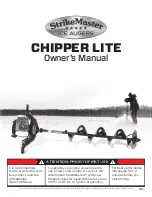
Miller SRL2-M Series
Rodless Cylinders
19
(7) Calculation examples for SRL2-M-20 with shock absorber
NCK-00-0.7-C.
Example 1. Vertical Mounting
Weight attached to piston table - 6lb.
Impact velocity upward -
32 in./sec.
Impact velocity downward -
39 in./sec.
Working pressure -
70 psi
Actual propelling force -
28 lb.
(see Figure 13, page 26)
Upward kinetic energy:
Eup = 6 · 32
2
+ (28-6) · 0.315 = 14.89 in.-lbs.
772
Downward kinetic energy:
Edn = 6 · 39
2
+ (28+6) · 0.315 = 22.53 in.-lbs.
772
Effective weight, upward:
We up = 6 +
772 · (28-6) · 0.315
= 11.22 lb.
32
2
Effective weight, downward:
We dn = 6 +
772 · (28+6) · 0.315 = 11.43 lb.
39
2
Eup = 14.89 is less than 1/2 times 60.8 (See Figure 4) - OK
Edn = 22.53 is less than 1/2 times 60.8 (See Figure 4) - OK
We up = 11.22 is less than 32 (See Figure 3) - OK
We dn = 11.43 is less than 31 (See Figure 3) - OK
Example 2. Horizontal Mounting
Weight attached to piston table - 6 lb.
Impact velocity -
36 in./sec.
Working Pressure -
50 psi
Actual propelling force -
20 lb.
(see Figure 13, page 26)
Kinetic energy:
E = 6 · 32
2
+ 20 · 0.315 = 16.37
772
We = 6 +
772 · 20 · 0.315
= 11.25
36
2
E = 16.37 is less than 1/2 times 60.8 (See Figure 4) - OK
We = 11.25 is less than 32 (See Figure 3) - OK
Intermediate Stroke Stop
Slit tube type rodless cylinders, by the nature of their design, will allow
a very small amount of air to leak externally including the SRL2-M
which has non-detectable, minimal leakage. To try to stop and hold a
cylinder in an intermediate position will require a three position valve
with both cylinder ports open to pressure in the circuit for more
satisfactory results. See Figures 5 and 6.
Horizontal Weight
The circuit in Figure 5 shows that equal pressure is applied to both
sides of the piston when it stops which prevents the table from jumping
out of position at restart.
Vertical Weight
As shown in Fig. 6, the table moves in the same direction as the weight
in a vertical application. Install a regulator with a check valve to reduce
the cylinder thrust on the upper side to balance the weight and force on
the lower side.
Figure 5
Figure 6
www.comoso.com














































